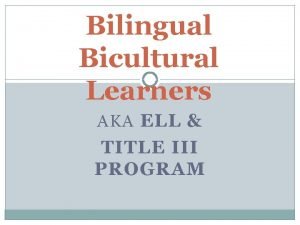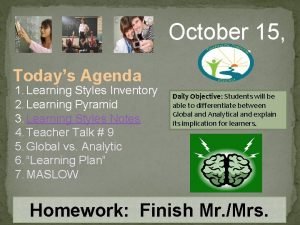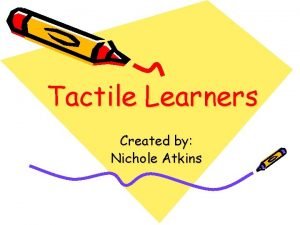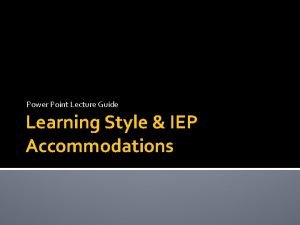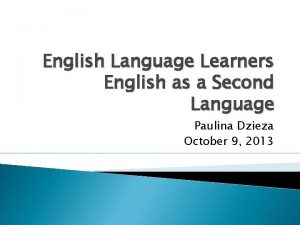Output Strategies for English Language Learners Theory to











- Slides: 11

Output Strategies for English. Language Learners: Theory to Practice by Angela R. Beckman Anthony Presentation by: Emily Mc. Abee & Jennifer Soto

Input vs. Output INPUT • Definition of Input • Importance of Input • Influences native language acquisition as well as second-language acquisition • Use of syntactically complex speech by the teacher • Providing • • • Quality Input Develop oral vocabulary prior to using texts for instructional purposes Develop comprehension skills Provide first language support Use early literacy assessments Encourage parent involvement in literacy learning

OUTPUT • Definition of Output • Examples of Output • The answers students provide on a test • The responses students provide when asked a question • Three Functions of Output • Noticing/triggering • Hypothesis testing • Metalinguistic/reflective

Encouraging Output • CREATE 1. 2. 3. 4. 5. A SUPPORTIVE LEARNING ENVIRONMENT Teach and reinforce explicit, repetitive procedures for problem solving or completing a task Scaffold task completion with teacher support Integrating literacy activities into other domains should be done strategically, by recognizing and applying students strengths Develop background knowledge Review materials and concepts

• COLLABORATIVE CONVERSATIONS • Requires a balance of turns between the teacher and students in the group To maximize opportunities for output: • Interactions should have a communicative goal • Students should be expected to contribute • Questions should be open-ended • Interaction may be structured but appropriate for the students’ ability level

• VOCABULARY Teachers can ensure quality vocabulary instruction by providing: • Contextualized, repetitive, meaningful introductions to unfamiliar words • Extended and repeated opportunities to engage in activities that offer interactions with new words • Opportunities for the students to connect new vocabulary to personal experiences

• WRITING Teachers can ensure quality writing instruction by providing: • Collaborative learning in the writing process • Opportunities for students to read aloud what they have written; this can be done in both their native and second language • Frequent opportunities for story and journal writing • Encouraging students to recognize differences between the ways the students’ native and second language are written

• READING Teachers can ensure quality reading instruction by: • Incorporating choral reading of texts • Utilizing texts for Readers Theatre • Allowing students to create their own scripts based on their interpretations of the story and its characters • Introducing think-alouds to students

Why English is so hard to learn: 1) The bandage was wound around the wound. 2) The farm was used to produce. 3) The dump was so full that it had to refuse more refuse. 4) We must polish the Polish furniture. 5) He could lead if he would get the lead out. 6) The soldier decided to desert his dessert in the desert. 7) Since there is no time like the present, he thought it was time to present the present. 8) bass was painted on the head of the bass drum. 9) When shot at, the dove into the bushes. 10) I did not object to the object. 11) The insurance was invalid for the invalid. 12) There was a row among the oarsmen about how to row. 13) They were too close to the door to close it. 14) The buck does funny things when the does are present. 15) A seamstress and a sewer fell down into a sewer line. 16) To help with planting, the farmer taught his sow to sow. 17) The wind was too strong to wind the sail. 18) After a number of injections my jaw got number. Unknown Author/Date of 19) Upon seeing the tear in the painting I shed a tear. publication. Why English is so 20) I had to subject the subject to a series of tests. hard to learn. Retrieved from 21) How can I intimate this to my most intimate friend? http: //bitsandpieces. us/2009/08/26/ why-english-is-so-hard-to-learn/

Handout entitled, “Looking at Language Archives” English is a Crazy Language Lederer, R. (1996). Looking at Language Archives: English is a Crazy Language. Retrieved from http: //www. verbivore. com/arc_ceng. htm#ce 1.

Article Citation Anthony, Angela R. B. (2008). Output Strategies for English-Language Learners: Theory to Practice. The Reading Teacher Vol. 61, No. 6 March 2008.
 Reading strategies for english language learners
Reading strategies for english language learners Assistive technology for english language learners
Assistive technology for english language learners English language learners
English language learners Cr part 154
Cr part 154 Questioning and discussion techniques
Questioning and discussion techniques Teaching young learners english
Teaching young learners english A level english language language change
A level english language language change Global vs analytical learners
Global vs analytical learners How to teach grammar to young learners
How to teach grammar to young learners Facts about tactile learners
Facts about tactile learners What is remedial teaching
What is remedial teaching Global vs analytical learners
Global vs analytical learners


